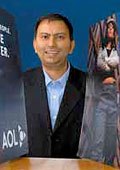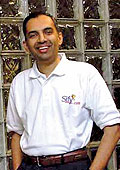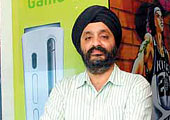|
Roving
arc-lights, a mock up of the Golden Gate Bridge and dark-suited
security men whispering into their two-way microphones. The visit
of AOL's Chief Operating Officer Ron Grant to India a couple of
weeks ago to launch the company's country-specific portal was
meant to be a high-decibel event. For good reason. AOL, which
has had a call centre in Whitefield, Bangalore, for about five
years now, is a lot late to the Indian internet market compared
to its global rivals such as Yahoo!, msn (of Microsoft) and Google.
That's a pity because, as part of the $44-billion media behemoth
AOL Time Warner, AOL is the only media conglomerate of the four.
"We're very excited about our launch in India and believe
this market can be a key growth driver for us globally,"
says Grant.
Wait a second. What are we talking about
here? The future of global internet giants riding as much on India
as on the us and China? That's a joke isn't it, considering that
everyone knows India has less than 50 million internet users,
just a little over 2 million broadband connections and a minuscule
online advertising market worth Rs 240 crore? "It is definitely
not the current market base or size that is enticing any player
worth his salt to come here," admits Jaspreet Bindra, MD,
msn India. "Everybody wants to get in hoping that they can
play a seminal role in influencing the shape of the market."
Adds Sandeep Singhal, Managing Director, Sequoia India, the most
active venture capital (VC) firm in the Indian internet space:
"These numbers are eerily similar to those of the us a decade
ago. In 1997, in the US online ad spend was just around $65 million.
Today, it is probably more than $10 billion. I see a repeat of
that kind of growth happening in the Indian market."
 |
"If somebody
announces unlimited mail storage, others will offer it too"
George Zacharias
Managing Director/ Yahoo! India |
Well, folks, in case you haven't noticed,
the internet is back. In calendar 2006, according to Venture Intelligence,
27 dotcoms got funded compared to just two the year before. The
VC investment also shot up from $17 million to $166 million, and
in the first four months of this year, while fewer dotcoms have
been funded-four versus eight in the same period last year-the
average investment is higher at $5.25 million compared to $4.75
million. In some sense, then, this is Indian internet's second
coming. And this time around, there's a fundamental difference.
Earlier, VCs said 'show me the business plan', but now they are
saying 'show me the money'. Says R. Ramraj, former co-founder
CEO of Sify: "You will be laughed out if you try to raise
money based on just an idea. You need to have a concrete business
plan and indicate how exactly you are going to make money."
 |
"India
is a top growth driver for AOL and the growth of the online
ad market is a positive sign"
Manish Dhir
Executive VP/
AOL India |
From the overall internet environment, too,
things seem far more propitious and real. The market, for one,
is growing at close to 100 per cent year on year, and over the
next three years or so, the user base is expected to touch 100
million, with over 10 million broadband connections. The bandwidth
costs are falling by half every 18 months and those of storage
costs, every 12 months. it and Telecommunications Minister Dayanidhi
Maran is talking of cheap (perhaps, free) broadband, besides setting
up 100,000 cyber cafes in India's hinterland to bridge the current
digital divide. Some others are talking of low-cost PCs for kids,
while yet others are working on applications that don't require
users to be literate. Says Rajan Mehra, Country Manager, eBay
India: "Around 12,800 people in India use eBay as their primary
source of revenue and there is a growing number of such sellers,
specifically from the smaller towns. Going ahead, we see more
opportunities in the non-metros." Meanwhile, thanks to the
mobile revolution, millions of Indians are getting onto the wireless
bandwagon, giving marketers an alternative, but merging, technology
with which to tap them.
The biggest reason of all, and which is driving
old media towards the internet (see Attack of the Old Media, page
62), is that advertisers are getting serious about online advertising.
Says Tushar Vyas, National Director (Interaction), Group M: "Many
clients are talking about spending 8-10 per cent of their total
ad spends on online advertising." Such clients, Vyas says,
include marketers of mobile handsets, computers & peripherals,
travel & tourism, and banking and financial services. One
should add car-makers as well. Maruti Udyog, for instance, has
used the internet aggressively ever since it launched its B-segment
car Swift, and now it plans to launch a massive internet campaign
to promote its newly-launched sedan, the SX4, which already has
a micro-site (www.marutisx4.com). Says Mayank Pareek, General
Manager (Marketing), Maruti Udyog: "Online, you know your
customers better, they visit the site because they proactively
click a link after seeing an advert in some of the larger web-portals.
On TV, you hope that your target customer sees the advert, but
online you know that they have, and we can even target them better."
More importantly, a buck goes farther online than in any other
medium in India today. More about that later.
|
WIRELESS SWEET SPOT
In India, internet companies have to
crack the mobile market.
|
|
All
the major players on the internet are eyeing the mobile
space. If you are wondering why, the answer is simple. India
has an installed base of around 20 million PCs that is growing
by 5 million every year. In contrast, India's mobile phone
user base has crossed 170 million, with 6 million new connections
getting added every month. Jaspreet Bindra of MSN India
says that "the intersection between mobile and PC is
the Holy Grail. World over nobody has been able to completely
crack it". In India, it is even more of a challenge
because mobile operators control the entry point for value-added
services, and retain chunk of the revenues from such services.
Says the head of another portal who did not wish to be identified:
"Given the growth happening in voice, the operators
are not too focussed on value-added data services. But once
the ARPUs (average revenue per user) start declining, things
will improve."
Meanwhile, the internet companies are
taking baby steps towards mobile. AOL has engineered an
e-mail application specifically for mobiles, Google has
tied up with several mobile telecom firms for mobile search
(and is reportedly considering offering its other services
such as Google Talk, Maps and AdWords), while Yahoo has
launched a complete package for GPRS-enabled handsets called
Mobile Internet, which allows users to access its entire
suite of applications on their smart phones. Local players
such as travel portal Makemytrip.com and IRCTC have also
tailored applications for the cell phone, while many industry
watchers see hybrid companies such as JiGrahak that combine
the internet and mobile phone as the next big wave in India.
Others like Monster already offer SMS job alerts and may
soon allow users to upload resumes via mobile phones.
Sure, there are just two million smart
phones in India, and even fewer net-enabled, but that's
not a big hurdle. If consumers find enough value in buying
higher-end handsets, they will.
-Venkatesha Babu
|
 |
"We see
ourselves as the only real portal from India and benchmark
ourselves with global competition"
Ajit Balakrishnan
CEO/ Rediff.com |
The Portals Hot up
Typically, a portal is the first stop for
an internet user. According to some data, of the 40 minutes that
the internet user in India spends online, 23 minutes are spent
on portals, including e-mails. The advertising revenues for the
internet portals come from three sources: Classifieds, display,
and search. Most of the revenue from classifieds goes to domain-specific
verticals such as travel, jobs, matrimony or real estate (see
Vertical Limit, page 66), and what the general portals (Yahoo!,
msn, Rediff, Sify or AOL) get are money from display and search
ads. As can be expected, there is fierce competition for this
ad spend. Google, Yahoo!, msn and AOL joust not just with each
other, but also home-grown rivals Rediff and Sify. Each player,
therefore, is drawing up its own strategy to get a leg-up in the
online marketplace. Things like e-mail, instant messenger, and
search are all passé. These are considered hygiene factors.
Says George Zacharias, Managing Director, Yahoo! India: "If
somebody announces unlimited mail storage, others will offer it
too." So, each of them is plotting its own moves to attract
eyeballs, as well as improve stickiness. The goal: make their
own portal the entry point for your experience on the world wide
web.
AOL, for instance, offers unlimited e-mail
storage, but more importantly, has started a dedicated Bollywood
channel, CityGuide, an education portal and offers videos of top
global music hits to improve its stickiness. "The Indian
market is in its infancy as yet and we don't think internet users
have built up strong brand loyalty to any specific portals yet,"
reckons Manish Dhir, Executive vp and Country Head, India, AOL,
who was responsible for setting up the portal's India operations.
AOL is the first portal globally to have the head of its international
operations in Bangalore. "India is among the top two or three
growth drivers for AOL globally and the growth of the online ad
market and the broader markets are positive signs for us,"
says Dhir.
The person entrusted with the portal's India
operations P.G. Ponappa, Vice President and General Manager, AOL
India, sees the burgeoning online ad market as an immediate target.
"Today, less than 2 per cent of the ad spend is online, but
even if that goes to 4 per cent, that's a significant opportunity
for companies like us," he explains. Zacharias of Yahoo!
points out that in developed markets online ad spends tend to
be around 15 per cent of the total ad spend, and that it is 4-5
per cent even in China. "The moment we have 10 million broadband
connections and at least 5-10 per cent of the ad spend coming
online, we are talking serious numbers here," says Zacharias.
It isn't as far fetched as it sounds. Next year, the online jobs
(classifieds) market will become larger than its print counterpart
with revenues of $120 million.
|
THE MSN-YAHOO! DEAL
The deal makes sense for both as they
can take on Google together.
|
|
 For
more than a year now, there have been rumours of software
giant Microsoft making a bid for Yahoo!. Over the last few
weeks, the rumours have gained ground, and many expect Microsoft
to make a $50-billion bid for Yahoo!. The deal makes sense.
Both have a common enemy: Google, which started as a small
search engine but has grown into a monstrously ambitious
company that now wants to shake the foundations of Microsoft's
lucrative office suite applications by offering competing
but free open-source applications. Google, of course, is
also the net's most valuable at $145 billion (as on May
11, 2007). With Yahoo! in its bag, Microsoft would get access
to the former's much-touted search engine ad ranking platform
codenamed Project Panama, and thus challenge Google's stronghold
in the search-related advertising market. The hope in Redmond
must be that such a move will distract Google enough to
make it stay away from Microsoft's core business of software. For
more than a year now, there have been rumours of software
giant Microsoft making a bid for Yahoo!. Over the last few
weeks, the rumours have gained ground, and many expect Microsoft
to make a $50-billion bid for Yahoo!. The deal makes sense.
Both have a common enemy: Google, which started as a small
search engine but has grown into a monstrously ambitious
company that now wants to shake the foundations of Microsoft's
lucrative office suite applications by offering competing
but free open-source applications. Google, of course, is
also the net's most valuable at $145 billion (as on May
11, 2007). With Yahoo! in its bag, Microsoft would get access
to the former's much-touted search engine ad ranking platform
codenamed Project Panama, and thus challenge Google's stronghold
in the search-related advertising market. The hope in Redmond
must be that such a move will distract Google enough to
make it stay away from Microsoft's core business of software.
-VB
|
| |
INDIA INTERNET LAB
Internet's cool apps, made in
India. |
 |
| Global Team: Amazon has three
software centres in India that are part of global teams |
Internet giants are leveraging
India's software skills to come up with innovative and sticky
offerings for global markets. Want proof? Here you go: Yahoo!
Answers, Google's Mobile Search, Amazon A9 (a visual yellow
pages directory), MSN's Desktop TV and AOL's instant messenger…
all are examples of products and applications with a strong
India scent. Says George Zacharias, MD, Yahoo! India: "We
will leverage the talent base available here in India not
only to meet the requirements of our Indian operations but
also our global user base."
MSN India customised its desktop TV offering that runs
advertisements continuously on the home page and its partners'
pages to the needs of the Indian market. Jaspreet Bindra,
MD, MSN India, says that this feature has been used by MSN
elsewhere also. "The India centre is part of every
major development initiative at Google and we're also working
on a mobile search product for the global market from here,"
says Prasad Ram, R&D Head, Google India. Google India
engineers have also recently devised a Hindi transliteration
service for its Blogger product that could be expanded to
reach the global market. At Yahoo!, the move to relocate
Chief Product Officer Pete Deemer to the Indian R&D
centre is perhaps a sign of how serious the company is about
its local operations. Aside from Yahoo! Answers, this centre
has been designated as the centre of excellence for the
entire developing markets geography.
-Rahul Sachitanand
|
Advertisers, on their part, are coming up
with unique ways with which to create buzz or online communities
around their products. Hindustan Unilever launched a rather successful
campaign around the Sunsilkgangofgirls community portal. Procter
& Gamble has also created an online interactive community
for teen girls between 14 and 19 years of age, www.beinggirl.co.in
, around its Whisper feminine hygiene brand. In fact, Vyas of
Interaction has proof of how effective online medium is for brands:
"We have a very interesting case from Listerine where online
medium was primarily used," he says. As the brand has overarching
social proposition, the agency sought to place the message of
oral hygiene in personal interactions on Yahoo! messenger that
sought to weave in the "Listerine" lingo in everyday
conversations. It has worked, claims Vyas: "The brand sales
have gone up up three times post the communication." Validation
has come in from other ends as well-purchase intent and brand
awareness were measured in partnership with Yahoo! and Factortg
(proprietary methodology to measure online response). The readymade
online conversations, one-liners such as "boss really needs
to use Listerine", etc., were downloaded and the viral environment
saw it being propagated among a cool 300,000 users.
 |
"Our
understanding of the unique requirements of the Indian marketplace
is unparalleled"
V. Sivaramakrishnan
President (Portals division), Sify |
Local Relevance
All the portals, including the newcomer AOL,
know that the key to long-term survival is in being locally relevant.
Yahoo!, for example, says that it is localising its offerings
with content in nine different Indian languages. "We have
city specific pages that serve up information relevant to your
city. We are already doing this for 20 cities across the country,"
points out Zacharias. Google, not exactly a portal but almost
the default entry into the world wide web, admits that the key
to cracking the local market lies in regional language offerings.
"Our R&D team here has already worked on a Hindi transliteration
product for our Blogger product, and we provide search in multiple
Indian languages too," says Shailesh Rao, Managing Director
(Sales & Marketing), Google India. "We don't see the
Indian market as a far-flung outpost, and given that there could
be 100 million consumers in the next three years, we expect to
make significant investments here," he adds.
Google is a classic example of how new markets
can be created within the internet space in India. Before the
world's most feared internet company came to India, there was
literally no market for search-based advertising. Google got in
here and in just 36 months created a Rs 100-crore market out of
search advertising. With its recent acquisition of DoubleClick
and its AdWords initiative, Google says the market is accelerating.
Travel portal MakeMyTrip.com already gets 15 per cent of its traffic
from internet advertising alone by leveraging programmes such
as Google's AdWords. MSN India, on the other hand, has innovated
by putting a 'desktop TV' on its homepage and those of its partners.
"Instead of the standard click-per-model, we sell airtime
on these desktop TVs, which run ads. It has become a huge hit,"
says Bindra.
 |
"Everybody
wants to get in, hoping they can play a seminal role in influencing
the shape of the market"
Jaspreet Bindra
MD, MSN India |
How are the local portals, Rediff and Sify,
coping with the onslaught of internet biggies? "We see ourselves
as the only real portal from India and benchmark ourselves with
global competition," says Ajit Balakrishnan, who took an
early bet and launched Rediff.com in 1996, and today has Rs 160
crore in revenues. Sify, which also offers local content in regional
languages, says that because of its access business (it is also
an internet service provider, or ISP), it is uniquely placed to
take advantage of the growth happening in the Indian market. It
has 3,500 iWays, or branded cyber cafes, spread across 162 cities,
with 8,000 people accessing the net from these locations at any
given point in time. As an ISP, it has 10 per cent of the 2.2
million broadband connections. "As we scale up, we see significant
traction in all our businesses," says V. Sivaramakrishnan,
President (Portals division), Sify. "Our understanding of
the unique requirements of the Indian marketplace is unparalleled."
According to Subho Ray, President, Internet
and Mobile Association of India (IAMAI), the apex industry body,
the focus on regional language content is inevitable. "Fifty
per cent of the English-speaking market has already been tapped
by these companies and now they need to target the latent audience,"
he contends. This latent market includes the 100-million plus
mobile users in India, as well as a market that is offline currently,
due to connectivity issues and the lack of regional language applications
(see The Wireless Sweet Spot). "Markets such as e-commerce
and internet advertising will only take off once this happens,"
he adds.
But as the VCs and internet companies seem
to have sensed it, there's an inexorable shift happening towards
the internet. And if not tomorrow, then someday soon, the internet
will be the lingua franca of the most important consumers in a
country of more than a billion people.
-additional reporting by
Shamni Pande, Rahul Sachitanand, Kushan Mitra and Pallavi Srivastava
|









 For
more than a year now, there have been rumours of software
giant Microsoft making a bid for Yahoo!. Over the last few
weeks, the rumours have gained ground, and many expect Microsoft
to make a $50-billion bid for Yahoo!. The deal makes sense.
Both have a common enemy: Google, which started as a small
search engine but has grown into a monstrously ambitious
company that now wants to shake the foundations of Microsoft's
lucrative office suite applications by offering competing
but free open-source applications. Google, of course, is
also the net's most valuable at $145 billion (as on May
11, 2007). With Yahoo! in its bag, Microsoft would get access
to the former's much-touted search engine ad ranking platform
codenamed Project Panama, and thus challenge Google's stronghold
in the search-related advertising market. The hope in Redmond
must be that such a move will distract Google enough to
make it stay away from Microsoft's core business of software.
For
more than a year now, there have been rumours of software
giant Microsoft making a bid for Yahoo!. Over the last few
weeks, the rumours have gained ground, and many expect Microsoft
to make a $50-billion bid for Yahoo!. The deal makes sense.
Both have a common enemy: Google, which started as a small
search engine but has grown into a monstrously ambitious
company that now wants to shake the foundations of Microsoft's
lucrative office suite applications by offering competing
but free open-source applications. Google, of course, is
also the net's most valuable at $145 billion (as on May
11, 2007). With Yahoo! in its bag, Microsoft would get access
to the former's much-touted search engine ad ranking platform
codenamed Project Panama, and thus challenge Google's stronghold
in the search-related advertising market. The hope in Redmond
must be that such a move will distract Google enough to
make it stay away from Microsoft's core business of software.

